Growing onions in plastic bottles might sound like something out of a science fiction movie, but trust me, it’s a surprisingly effective and incredibly rewarding way to cultivate these flavorful bulbs right in your own home! Are you tired of buying onions at the grocery store, only to use half and watch the rest wither away in your crisper drawer? Or maybe you’re short on garden space but still dream of harvesting your own fresh produce? Well, you’re in the right place!
For centuries, humans have cultivated onions, with evidence suggesting their use dates back over 5000 years! From ancient Egypt, where they were revered and even used as offerings, to medieval Europe, where they were believed to ward off evil spirits, onions have a rich and fascinating history. Now, we’re taking this time-honored tradition and giving it a modern, eco-friendly twist.
This DIY guide will walk you through a simple yet ingenious method for growing onions in plastic bottles, transforming discarded waste into a thriving mini-garden. Not only is this a fantastic way to recycle and reduce your environmental footprint, but it also allows you to control the growing environment, ensuring a bountiful harvest even in limited spaces. I’ll show you how to create the perfect setup, from preparing the bottles to nurturing your onion plants, so you can enjoy fresh, homegrown onions whenever you need them. Let’s get started and unlock the secrets to successful bottle gardening!
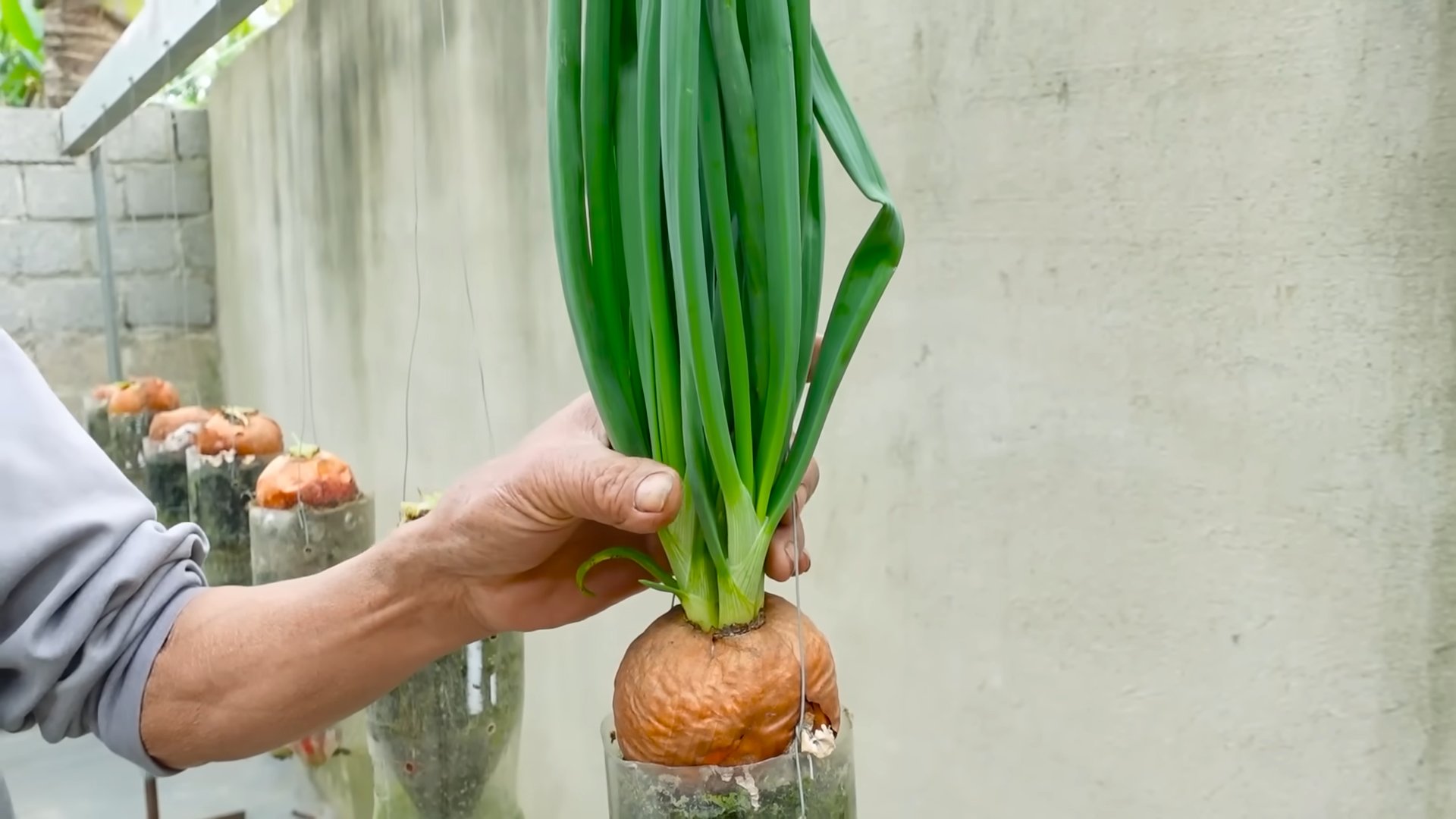
Growing Onions in Plastic Bottles: A Beginner’s Guide
Hey there, fellow gardening enthusiasts! Are you short on space but still dreaming of fresh, homegrown onions? Well, you’re in luck! I’m going to walk you through a super cool and surprisingly effective method: growing onions in plastic bottles. It’s a fantastic way to recycle, save space, and enjoy delicious onions right from your balcony or windowsill. Let’s get started!
What You’ll Need
Before we dive in, let’s gather our supplies. This is a pretty low-cost project, which is always a win!
* Plastic Bottles: The star of the show! I recommend using 2-liter soda bottles or larger water bottles. The taller the bottle, the better, as it gives the onions more room to grow. You’ll need one bottle per onion or cluster of onions you plan to grow.
* Potting Soil: A good quality potting mix is essential. Avoid using garden soil directly, as it can be too dense and may not drain well in a container. Look for a mix that’s light and airy.
* Onion Sets or Seedlings: You can use onion sets (small, immature onions) or onion seedlings. Sets are generally easier for beginners, but seedlings offer more variety. I personally prefer sets for their convenience.
* Scissors or a Utility Knife: For cutting the plastic bottles. Be careful!
* Watering Can or Spray Bottle: For watering your onions.
* Optional:
* Gloves: To keep your hands clean.
* Small Pebbles or Gravel: For drainage.
* Fertilizer: A balanced liquid fertilizer to give your onions a boost.
* Labels: To mark the type of onion you’re growing.
Preparing the Plastic Bottles
This is where we transform those discarded bottles into mini onion farms!
1. Clean the Bottles: First things first, thoroughly clean the plastic bottles with soap and water. Remove any labels and residue. This will prevent any unwanted contaminants from affecting your onions.
2. Cut the Bottles: Now, carefully cut the top off each bottle. You can cut it straight across, about 4-6 inches from the top. I like to use a utility knife to start the cut and then finish with scissors. Be extremely cautious when using a utility knife!
3. Drainage Holes: This is crucial for preventing waterlogging. Poke several drainage holes in the bottom of each bottle. You can use a nail, a screwdriver, or even the tip of your scissors (again, be careful!). Aim for at least 5-6 holes.
4. Optional: Add a Drainage Layer: To further improve drainage, you can add a layer of small pebbles or gravel to the bottom of each bottle before adding the soil. This helps prevent the roots from sitting in water.
Planting the Onions
Alright, time to get our hands dirty (or gloved, if you prefer)!
1. Fill the Bottles with Soil: Fill each bottle with potting soil, leaving about an inch or two of space at the top. Gently pat the soil down to remove any air pockets.
2. Plant the Onion Sets or Seedlings:
* For Onion Sets: Make a small hole in the soil, about an inch deep. Place the onion set in the hole, root-end down, and cover it with soil. The tip of the onion set should be just barely visible above the soil.
* For Onion Seedlings: Carefully separate the seedlings and make a small hole in the soil for each one. Gently place the seedling in the hole, making sure the roots are covered. Space the seedlings about 2-3 inches apart.
3. Water Thoroughly: After planting, water the onions thoroughly until the water drains out of the drainage holes. This helps settle the soil and encourages root growth.
Caring for Your Onions
Now comes the part where we nurture our little onion plants and watch them grow!
1. Sunlight: Onions need plenty of sunlight, so place your bottles in a sunny location. Aim for at least 6-8 hours of direct sunlight per day. A south-facing window or a sunny balcony is ideal.
2. Watering: Water your onions regularly, but be careful not to overwater. The soil should be moist but not soggy. Check the soil moisture by sticking your finger into the soil. If the top inch feels dry, it’s time to water.
3. Fertilizing: To give your onions a boost, fertilize them every 2-3 weeks with a balanced liquid fertilizer. Follow the instructions on the fertilizer packaging. I like to use a fertilizer that’s specifically formulated for vegetables.
4. Weeding: Keep an eye out for weeds and remove them promptly. Weeds can compete with your onions for nutrients and water.
5. Rotation: Rotate the bottles regularly to ensure that all sides of the onions receive equal sunlight. This will help them grow evenly.
6. Pest Control: Keep an eye out for pests, such as aphids or onion maggots. If you notice any pests, you can try spraying them with insecticidal soap or neem oil.
Harvesting Your Onions
The moment we’ve been waiting for!
1. When to Harvest: Onions are typically ready to harvest when the tops start to turn yellow and fall over. This usually takes about 3-4 months, depending on the variety and growing conditions.
2. How to Harvest: Gently pull the onions out of the soil. If the soil is dry, you may need to loosen it first.
3. Curing: After harvesting, cure the onions by laying them out in a warm, dry, and well-ventilated place for about 1-2 weeks. This allows the outer layers to dry and helps prevent rot.
4. Storing: Once the onions are cured, you can store them in a cool, dry, and dark place. Braiding the tops together and hanging them is a traditional and attractive way to store onions.
Troubleshooting
Even with the best intentions, things don’t always go according to plan. Here are a few common problems you might encounter and how to deal with them:
* Yellowing Leaves: This could be a sign of overwatering, underwatering, or nutrient deficiency. Check the soil moisture and adjust your watering accordingly. If the soil is consistently moist, reduce watering. If the soil is dry, water more frequently. You can also try fertilizing your onions to provide them with the nutrients they need.
* Slow Growth: This could be due to insufficient sunlight, poor soil, or lack of fertilizer. Make sure your onions are getting enough sunlight and that the soil is well-draining and nutrient-rich. Fertilize regularly to provide them with the nutrients they need to grow.
* Rotting Onions: This is usually caused by overwatering or poor drainage. Make sure the bottles have adequate drainage holes and avoid overwatering. If you notice any rotting onions, remove them immediately to prevent the rot from spreading.
* Pests: Keep an eye out for pests and take action promptly. Insecticidal soap or neem oil can be effective for controlling many common onion pests.
Choosing the Right Onion Variety
The type of onion you choose to grow will depend on your personal preferences and climate. Here are a few popular varieties that are well-suited for container gardening:
* Green Onions (Scallions): These are quick and easy to grow, and you can harvest them continuously as needed.
* Shallots: These have a mild, sweet flavor and are great for cooking.
* Red Onions: These have a slightly pungent flavor and are good for salads and grilling.
* Yellow Onions: These are the most common type of onion and are versatile for cooking.
* White Onions: These have a mild, sweet flavor and are good for sauces and soups.
Tips for Success
Here are a few extra tips to help you succeed with growing onions in plastic bottles:
* Use a good quality potting mix. Avoid using garden soil directly, as it can be too dense and may not drain well in a container.
* Don’t overwater. Onions prefer moist soil, but they don’t like to sit in water.
* Fertilize regularly. Onions are heavy feeders and need plenty of nutrients to grow.
* Provide plenty of sunlight. Onions need at least 6-8 hours of direct sunlight per day.
* Rotate the bottles regularly. This will ensure that all sides of the onions receive equal sunlight.
* Be patient. It takes time for onions to grow, so don’t get discouraged if you don’t see results immediately.
Experiment and Have Fun!
The best part about DIY gardening is the opportunity to experiment and learn. Don’t be afraid to try different onion varieties
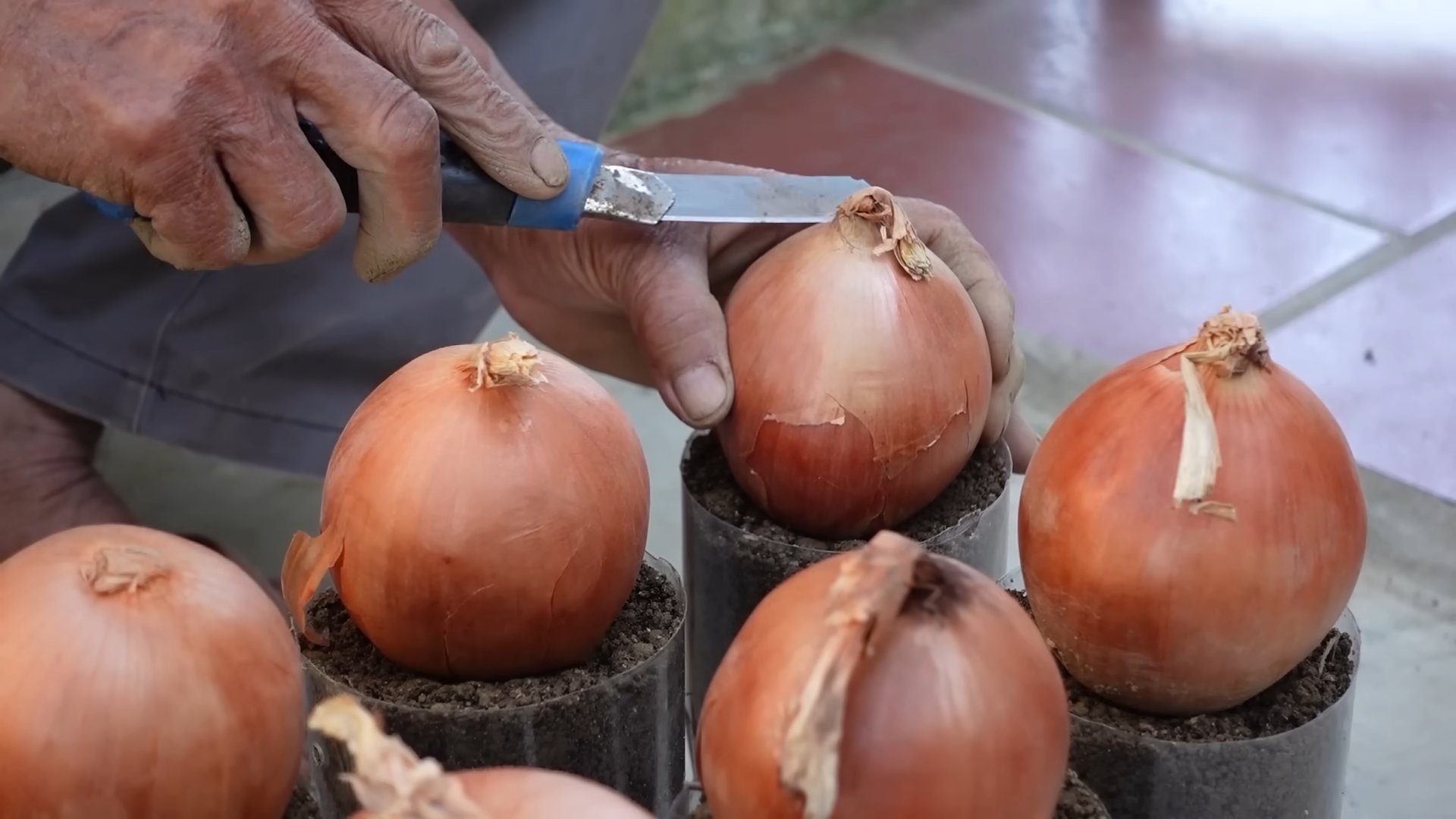
Conclusion
So, there you have it! Growing onions in plastic bottles isn’t just a quirky gardening experiment; it’s a surprisingly effective and space-saving method that can bring the joy of fresh, homegrown onions right to your windowsill or balcony. We’ve explored the simple steps, from preparing your bottles and soil to planting and nurturing your onion sets. But why should you actually give this a try?
Firstly, it’s incredibly accessible. You’re likely already recycling plastic bottles, turning what would be waste into a productive mini-garden. This makes it an eco-friendly choice, reducing your environmental footprint while simultaneously providing you with delicious onions. Secondly, the space-saving aspect is a game-changer for urban dwellers or anyone with limited garden space. You can stack these bottle gardens vertically, maximizing your yield in a minimal area. Imagine a wall of green, bursting with the promise of flavorful onions!
Beyond the practicality, there’s a certain satisfaction that comes from nurturing something from seed (or in this case, set) to harvest. Watching your onions sprout and grow within their recycled containers is a rewarding experience, connecting you to the natural world in a tangible way. And let’s not forget the taste! Homegrown onions, bursting with freshness, are simply superior to store-bought varieties. They add a depth of flavor to your cooking that you just can’t replicate.
But don’t stop there! This method is ripe for experimentation. Try different varieties of onions – red, yellow, white, or even shallots. Experiment with different soil mixes to see what works best for your climate and growing conditions. Consider adding companion plants like marigolds or basil to deter pests and enhance growth. You could even create a tiered system using multiple bottles, creating a visually stunning and productive vertical garden.
Ready to embark on your own plastic bottle onion-growing adventure? We wholeheartedly encourage you to give it a try. It’s a fun, affordable, and rewarding project that will bring fresh onions to your table and a touch of green to your space. Don’t be afraid to get your hands dirty and experiment.
And most importantly, we want to hear about your experiences! Share your photos, tips, and challenges in the comments below. Let’s create a community of bottle-gardeners, learning from each other and celebrating the joys of homegrown onions. Did you find a particular type of bottle worked better? Did you encounter any unexpected challenges? Your insights could help others succeed. So, grab those plastic bottles, prepare your soil, and get ready to grow some delicious onions! This DIY trick is a must-try for any gardener, beginner or experienced, looking for a sustainable and space-saving way to enjoy fresh, flavorful onions.
Frequently Asked Questions (FAQ)
What type of plastic bottles are best for growing onions?
Ideally, you should use sturdy, food-grade plastic bottles. Two-liter soda bottles or larger water bottles work well. Avoid bottles that have contained harsh chemicals, as these could contaminate your soil and onions. Make sure to thoroughly clean the bottles before using them. Clear or translucent bottles are preferable as they allow you to monitor the soil moisture levels. Darker bottles can also be used, but you’ll need to be more diligent about checking the soil.
How often should I water my onions grown in plastic bottles?
Watering frequency depends on several factors, including the climate, the type of soil you’re using, and the size of the bottle. Generally, you should water when the top inch of soil feels dry to the touch. Avoid overwatering, as this can lead to root rot. Ensure that your bottles have adequate drainage holes to prevent water from pooling at the bottom. During hot, dry weather, you may need to water daily, while during cooler, wetter periods, you may only need to water every few days. A good rule of thumb is to check the soil moisture regularly and water accordingly.
What kind of soil should I use for growing onions in plastic bottles?
A well-draining potting mix is essential for growing healthy onions in plastic bottles. You can use a commercially available potting mix or create your own by combining equal parts of garden soil, compost, and perlite or vermiculite. The compost provides nutrients, while the perlite or vermiculite improves drainage and aeration. Avoid using heavy clay soil, as it can become waterlogged and suffocate the roots. The ideal soil pH for onions is between 6.0 and 7.0.
How much sunlight do onions need when grown in plastic bottles?
Onions need at least 6-8 hours of direct sunlight per day to thrive. Place your bottle gardens in a sunny location, such as a south-facing window or balcony. If you don’t have access to enough natural sunlight, you can supplement with grow lights. Rotate the bottles regularly to ensure that all sides of the plants receive adequate light. Insufficient sunlight can result in weak, leggy growth and smaller bulbs.
Can I grow onions from seed in plastic bottles, or should I use sets?
While you can grow onions from seed in plastic bottles, using sets is generally easier and faster. Onion sets are small, immature bulbs that are already partially grown, giving them a head start. Starting from seed requires more time and attention, as the seedlings are more delicate and susceptible to pests and diseases. If you choose to grow from seed, start them indoors several weeks before the last expected frost and transplant them into your bottle gardens once they are large enough to handle.
How do I fertilize onions grown in plastic bottles?
Onions are heavy feeders and benefit from regular fertilization. Use a balanced liquid fertilizer, such as a 10-10-10 or 20-20-20, diluted to half strength. Fertilize every 2-3 weeks during the growing season. You can also add compost tea or worm castings to the soil to provide additional nutrients. Avoid over-fertilizing, as this can lead to excessive foliage growth at the expense of bulb development.
How do I protect my onions from pests and diseases when grown in plastic bottles?
Growing onions in plastic bottles can help to minimize pest and disease problems, as the elevated containers provide better air circulation and reduce contact with soilborne pathogens. However, it’s still important to monitor your plants regularly for signs of pests or diseases. Common onion pests include thrips, onion maggots, and aphids. Diseases include downy mildew, onion smut, and bulb rot. If you detect any problems, treat them promptly with appropriate organic pesticides or fungicides. Companion planting with marigolds or basil can also help to deter pests.
When are onions ready to harvest when grown in plastic bottles?
Onions are typically ready to harvest when the tops begin to turn yellow and fall over. This usually occurs about 90-120 days after planting sets. Gently pull the onions from the soil and allow them to dry in the sun for a few days before storing them. Store onions in a cool, dry, well-ventilated place.
Can I reuse the plastic bottles for growing onions again?
Yes, you can reuse the plastic bottles for growing onions or other plants multiple times. However, it’s important to thoroughly clean and disinfect the bottles between uses to prevent the spread of diseases. Wash the bottles with soap and water, and then rinse them with a solution of 1 part bleach to 9 parts water. Allow the bottles to air dry completely before reusing them.
What are some variations I can try with this method?
Beyond different onion varieties, you can experiment with growing other vegetables in plastic bottles using a similar method. Herbs like basil, mint, and oregano thrive in containers. You can also try growing smaller vegetables like lettuce, spinach, or radishes. Consider painting the bottles to add a decorative touch to your garden. You can also create a self-watering system by adding a water reservoir to the bottom of the bottle. The possibilities are endless!
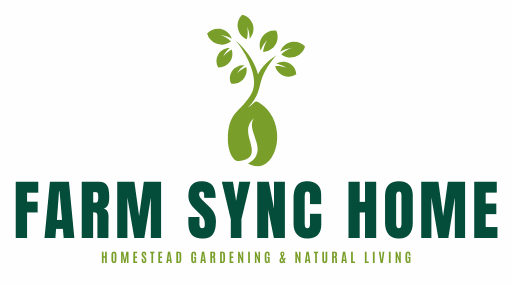
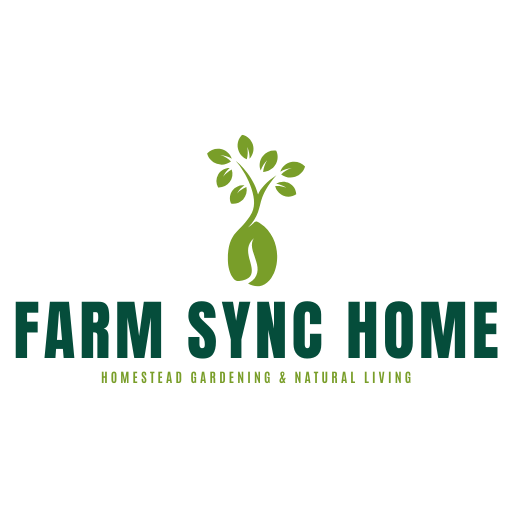
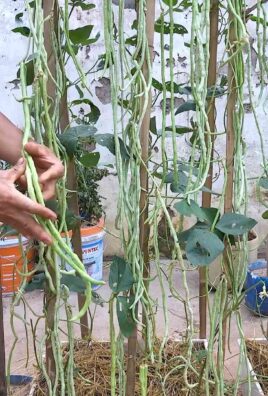
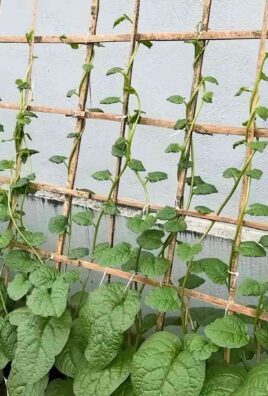
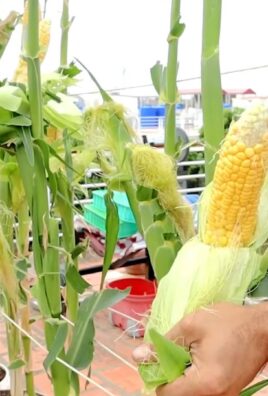
Leave a Comment